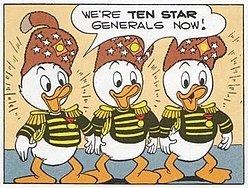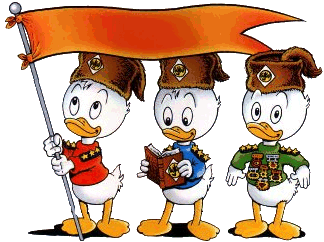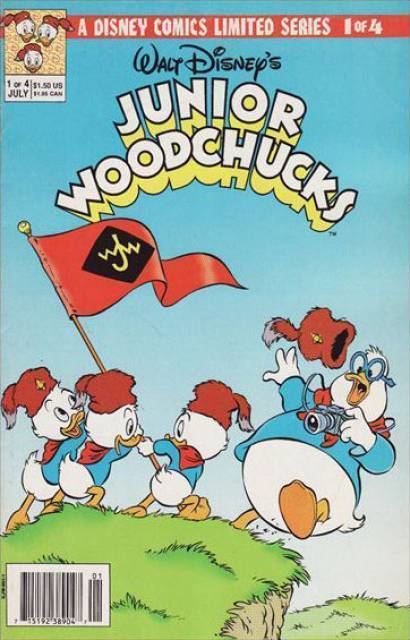 | ||
The Junior Woodchucks of the World are the Scouting organization to which the Disney characters Huey, Dewey, and Louie belong. The Junior Woodchucks were created by Carl Barks in 1951, in the story "Operation St. Bernhard" (Walt Disney's Comics and Stories #125). Later stories introduced a similar organization for girls, the Littlest Chickadees, to which Daisy Duck's nieces, April, May and June belong. The hallmark of the Junior Woodchucks is their spirited dedication to environmental protection and animal welfare, as well as the preservation of knowledge and the furtherance of science. They are also known for their exalted titles and ranks (Huey, Dewey, and Louie being promoted to become Ten-Star Generals in the 1951 story of the same name) and the awarding of buckets of badges, along with severe ideals as to decorum. In this way Barks poked gentle but pointed satire at aspects of the Boy Scouts of America.
Contents
- History
- Organization
- Leadership
- Troops
- General Snozzie
- The Littlest Chickadees
- The Little Booneheads
- Junior Woodchucks Guidebook
- List of comics
- International versions
- In other media
- References

Junior Woodchucks always carry with them a copy of the Junior Woodchucks' Guidebook, a fictional guidebook filled with detailed and pertinent information about whatever country or situation the Woodchucks find themselves. Its depth of coverage is remarkable, considering that it is a small paperback book.

Don Rosa wrote and drew a story regarding the origin of the Junior Woodchucks' Guidebook, "Guardians of the Lost Library", which Comics Buyer's Guide mentioned as possibly the greatest comic book story of all time. Rosa's later story W.H.A.D.A.L.O.T.T.A.J.A.R.G.O.N. tells of how Huey, Dewey, and Louie came to join the Junior Woodchucks.

In 1971 Carl Barks drew a model sheet of the nephews, with some of the drawings showing them in their Junior Woodchuck uniforms, for the Disney studio's publications department.

Most of the early Junior Woodchucks stories appeared in Walt Disney's Comics and Stories. They also appeared in Donald Duck and in Uncle Scrooge. In 1966, they got their own title, Huey, Dewey, and Louie and the Junior Woodchucks, published by Gold Key Comics for 62 issues, and then continued by Whitman Comics for another 20 issues until 1983. The stories which Carl Barks wrote for this comic book, among the last comic book stories he scripted, were drawn by Kay Wright, John Carey and Tony Strobl. More recently Daan Jippes has been commissioned by Egmont to redraw these stories emulating Barks' style and drawing inspiration from the sketches of Barks' storyboard-like scripts.
Disney Comics published a Junior Woodchucks four issue mini series in 1991.
History
In the story W.H.A.D.A.L.O.T.T.A.J.A.R.G.O.N. by Don Rosa the history of the Junior Woodchucks of the World begins with the Woodchuck Militia, a defensive army unit that was formed by Cornelius Coot in the early 19th century to protect Fort Duckburg from Native Americans and other threats in the area. Clinton Coot, the son of Cornelius Coot, was the founder of the Junior Woodchucks as a Scouting organization for the children around Duckburg at the time to uphold the ideals of doing good deeds, protection of the wild lands and the preservation of knowledge. The organization eventually grew larger to include all the nations around the world. The first Junior Woodchucks were Grand Marshal Osborne and Exalted Overseer Taliaferro (a reference to Ted Osborn and Al Taliaferro) and Fulton Gearloose, the father of Gyro Gearloose.
Organization
With its predecessor being a militia, The Junior Woodchucks is very militaristic in its organization with the leadership being much more similar to army officers than to real-life Scoutmasters and the scout groups are called Troops in which titles like Trooper, Lieutenant-General, Field Marshal and Ten-Star General include. Alongside self-reliance, trust and honor are important to the Junior Woodchucks, as its members never lie. For instance when Huey, Dewey and Louie promised the inhabitants of the secret sunken city of Atlantis to never reveal their city's location to the outside world.
As the title of the Junior Woodchucks of the World suggest, it is an international organization and has Troops all around the globe, including Arabia (which consist of Desert Patrol nr. 646), Brazil (which consist of the Rio de Janeiro Troops) and the Duckburg Troops of the United States.
Leadership
The adult leadership of the Junior Woodchucks consists of Troop leaders (or Grand Moguls in European comics) whom often has elaborate, grand and long acronymized titles which demonstrates their ranking position and professional field. They have also been called Generals in a few stories by Carl Barks. The Troop leaders' uniforms is militaristic in design and is often white in color with richly decorated gold embroideries; with their headgear often being a woodchuck cap or other types of military headwear. They are also often wearing a large number of meritorious and elaborate medals, badges and ribbons which makes them look very dignified and grandiose, and in some cases extremely pompous. Only Junior Woodchucks can later become Troop leaders.
Again, according to Don Rosa's story W.H.A.D.A.L.O.T.T.A.J.A.R.G.O.N. the Junior Woodchucks of the World is governed by the Supreme Council; which is probably part of the World Office of the Junior Woodchucks, which is the organization's top office. The council consists of nine high-ranking members whom collectively is called the B.I.G.S.H.OT.S. (Bureaucratic and Imposing Gathering of Supreme High Officials of the Topmost Strata) with the H.E.A.D.H.O.N.C.H.O. (Highest Executive Administrator of Divisional Headquarters and Organizer of Nearly Complete Hierarchical Overkill) as the head of the council. The Supreme Council is located in the Junior Woodchucks' World Headquarter in the City of Duckburg.
However other high ranking titles of uncertain position in leadership has been used within the organization in stories by Carl Barks and others. Some of these include Commander-in-Chief and Exalted Grand Marshal.
A few other acronymized titles within the Junior Woodchucks' leadership include:
On few occasions Donald Duck has taken on the role as a Troop leader (although in Don Rosa's story W.H.A.D.A.L.O.T.T.A.J.A.R.G.O.N., Donald is revealed to never having been allowed to join the Junior Woodchucks on account of his "hot temper"), or by Launchpad McQuack in the DuckTales TV-series. In a large number of stories, including the last ones written by Carl Barks, the Duckburg Troop leader is a tall duck, who is either the same character in every story with many different titles depending on the situation or separate characters. In some Italian stories the Troop leader of the Duckburg Troop is a tall, strong and wise (but afraid of flight) goose whose name is Bertie McGoose.
Troops
To become a full member of the Junior Woodchucks and be assigned to a local Troop one must first enlist as cadets, who uses no-tails woodchuck caps, and pass an initiation test that proves one's intelligence and resourcefulness. After one has passed this test and become a full member, the headgear of the uniform consist of a backtail woodchuck cap and for higher-ranking members; the Exalted Hightail woodchuck cap. Within the Troops there is also leadership titles inspired by the army, in which Major seems to be the lowest rank followed by higher ranking titles like Ten-Star General; which is one grade below Exalted Hightail. Don Rosa has written that One-Hundred-Star General is the highest title in the Junior Woodchucks; after which promotees can proceed to earn titles above the highest ranks. Holders of these titles can issue orders to lower ranking members. To earn titles and get promotions in rank one have to pass tests or missions of which there is a vast number and in various fields. These include outdoors and survival skills, science and environmental protection etc. With these promotions, Junior Woodchucks receive a large number of honorific and elaborate medals, badges and ribbons in the specific field that one has mastered. All the different Troops also has its own clubhouse as a base of operation and for gatherings. The most prestigious Troop to belong to was the Duckburg Troop Nr. 1 as it was the first to be created during the time of Clinton Coot and it only admitted high-ranking members from other local Troops.
The best known members of the Duckburg Troop Nr. 1 consist of:
General Snozzie
General Snozzie is the Official Hound of the Junior Woodchucks and was created by Carl Barks in his story Dodging Miss Daisy from 1958. General Snozzie is a bloodhound occasionally deployed by the Junior Woodchucks during tests or missions and he has many skills but his main attribute and discipline is his extraordinary, and at times incomprehensibly, good scent tracking. He also has a number of acronymized titles which include: D.O.G. (Doctor of Odd-ball Gimmickry), S.S.S.S. (Supremely Sagacious Spoor Sniffer), and K.I.N.G. (Knightly, Intrepid, Natatorial Guardian). General Snozzie also has a Ph.D., B.Sc., and Ed.D.
The Littlest Chickadees
The Littlest Chickadees, sometimes also called the Chickadee Patrols, are female counterparts to the Junior Woodchucks. The Chickadees first appeared in "The Chickadee Challenge," a Carl Barks Donald Duck story in Walt Disney's Comics and Stories #161 (1954). The Chickadees' Duckburg patrol is led by a brawny woman named Captain Ramrod. Daisy Duck's nieces April, May, and June are members of the Chickadees. The Chickadees are named after the chickadee, a species of small bird; the phrase "littlest chickadee" also suggests "my little chickadee", a term of endearment classically used by W. C. Fields.
The Chickadee Patrols are based to some extent on the Girl Scouts of the USA and the Campfire Girls. In the spirit of friendly rivalry, the Duckburg Troops of the Littlest Chickadees and Junior Woodchucks once held a bridge-building competition, which ended in a tie.
Carl Barks wrote a poem which mentions the rivalry between the two groups:
The world is full of clans and cults
Abuzz as angry bees
And Junior Woodchucks snapping jeers
At Littlest Chickadees
The Little Booneheads
The Little Booneheads is another Scouting organization alongside the Junior Woodchucks, first mentioned in Ten-Stars Generals (Walt Disney's Comics and Stories #132, 1951) by Carl Barks. They are however often depicted to be much more insufficient, and at times even negligent, in their outdoors and survival skills in contrast to the high standards of the Junior Woodchucks. In the Little Booneheads first appearance, it was revealed that Donald Duck was a former member, and thanks to the organization's inferior training, Donald is often getting into trouble for practicing them again. Alongside being a pun of the term "bonehead", the Little Booneheads is also a reference to the pioneer and explorer Daniel Boone; as Donald proclaims: "We had heads like Daniel Boone!".
Junior Woodchucks' Guidebook
The Junior Woodchucks' Guidebook and Reservoir of Inexhaustible Knowledge, or the Junior Woodchucks' Guidebook or Woodchuck book for short, appears to contain information and advice on every possible subject. Huey, Dewey, and Louie frequently consult a volume of the set to get themselves and their uncles Donald Duck and Scrooge McDuck out of dangerous situations (see deus ex machina). It was first mentioned in The Secret of Atlantis by Carl Barks in 1954, then called the Junior Woodchucks' Book of Knowledge. Its history was later discussed in Guardians of the Lost Library by Don Rosa in 1993.
According to the cartoonist Don Rosa, this book was written by the Guardians of the lost Library of Alexandria, compiling the essence of all the knowledge that was unique to the Library. It was later found by Cornelius Coot who gave the book to his son Clinton Coot who, in turn, was inspired to found The Junior Woodchucks as a continuation of the Guardians of the Library. One story that is not by Don Rosa says that the Guidebook is updated by an unknown author.
The Woodchuck book seems almost magical in its breadth of information; it almost never fails to provide the required information and yet is small enough to fit into a Junior Woodchuck's backpack. In particular, the Guidebook contains information on lost treasure, a complete survival guide, extensive historical and technical information and phrase books for various more or less common languages (like a minimal lizard phrase book), and many more. However, it does not contain information that a Junior Woodchuck is already supposed to know, such as the location of Cape of Good Hope nor does it contain information on allegedly non-existent things. (In one episode of Duck Tales, the three nephews faced a dragon and when they consulted the Guidebook, the entry on dragons read that since dragons did not exist, there was no reason to include information on them. However, in the story on which that episode was based, the guidebook did have an entry on dragons. And, in a story which appeared in Uncle Scrooge entitled "The Golden Fleecing" the ducklings looked up the question, how to put a dragon to sleep, and found the answer, Pull the wool over his eyes. The boys then covered the dragon's eyes with the Golden Fleece, which they had just discovered by going to Colchis on the Argo and obtaining it from the Harpies.) On the other hand, the Guidebook does have information on Martian technology, despite the fact that in the DuckTales universe Martians had not been discovered when the book was printed. It is missing only one fact: The ranking order of the original Knights Templar, plus one discovered in an ancient Xanadu manuscript. In short, it is a minimal encyclopedia (although the subset of articles is extraordinarily well-chosen), available only to Junior Woodchucks.
Information is readily available by searching the extensive index; a key skill of a Junior Woodchuck is being able to retrieve information quickly from the Woodchuck book in the midst of a dangerous situation, such as a bear attack, an earthquake, falling out of an airplane sans parachute, or being swallowed by a crocodile. However, in one Carl Barks story, it took the ducklings so long to look up a lifesaving question, it was almost too late. Scrooge subsequently offered to buy the Junior Woodchucks a better index for the Guidebook.
Just as the Junior Woodchucks are based on the Boy Scouts of America, their Guidebook is inspired by the Boy Scout Handbook. The real Handbook (at least in the 1950s) was the same size as the Guidebook and was believed by all Scouts to contain all necessary information. In this respect, the almost limitless and sometimes esoteric knowledge the Junior Woodchucks' Guidebook offers is a gently satirical comment on the "Scout Bible", as the original Scouting For Boys by Baden-Powell was sometimes known, a book giving advice on a vast range of subjects, including "Smoking", "How The Empire Must be Held", "Courtesy To Women", and "How to Revive A Suicide".
That guide was the inspiration for the "Junior Woodchucks' Guidebook" (Il Manuale delle Giovani Marmotte), a series of several Disney books with tips, advice, general culture, and curious facts about nature and life, released in Italy by Mondadori in seven volumes between 1969 and 1974, and later translated into several languages.
List of comics
International versions
In other media
In the 1970s Bob Rozakis called his fellow young fans turned DC Comics editorial employees Junior Woodchucks and they referred to themselves as such in the pages of the pro-zine The Amazing World of DC Comics which they co-edited.
Comedian Jeff Foxworthy once claimed, in his TV show, to have been a member of the Junior Woodchucks in his childhood.
In some episodes of the comic strip Big Nate, Nate Wright and his Middle-school friends are members of the Junior Woodchucks.
